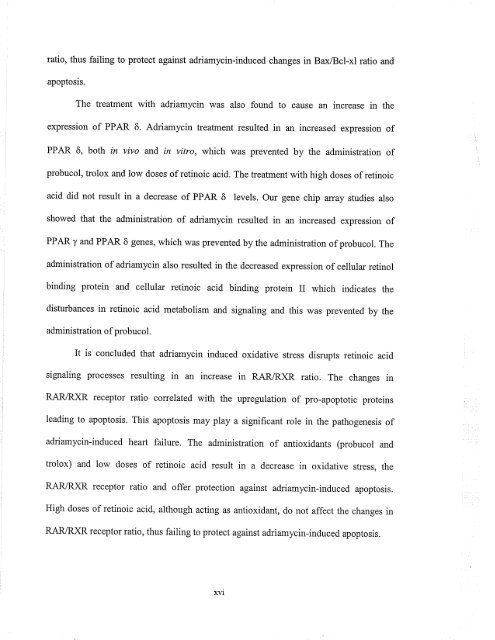il\VOLVEMENT OF RETII\OIC ACID II{ - MSpace at the University of ...
il\VOLVEMENT OF RETII\OIC ACID II{ - MSpace at the University of ...
il\VOLVEMENT OF RETII\OIC ACID II{ - MSpace at the University of ...
Create successful ePaper yourself
Turn your PDF publications into a flip-book with our unique Google optimized e-Paper software.
<strong>at</strong>io, thus failing to protect against adriamycin-induced changes in Bax/Bcl-xl r<strong>at</strong>io and<br />
apoptosis.<br />
The tre<strong>at</strong>ment with adriamycin was also found to cause an increase in <strong>the</strong><br />
expression <strong>of</strong> PPAR ô. Adriamycin tre<strong>at</strong>ment resulted in an increased expression <strong>of</strong><br />
PPAR ô, both in vivo and in vitro, which was prevented by <strong>the</strong> administr<strong>at</strong>ion <strong>of</strong><br />
probucol, trolox and low doses <strong>of</strong> retinoic acid. The tre<strong>at</strong>ment with high doses <strong>of</strong> retinoic<br />
acid did not result in a decrease <strong>of</strong> PPAR ô levels. Our gene chip anay studies also<br />
showed th<strong>at</strong> <strong>the</strong> administr<strong>at</strong>ion <strong>of</strong> adriamycin resulted in an increased expression <strong>of</strong><br />
PPAR y and PPAR ô genes, which was prevented by <strong>the</strong> administr<strong>at</strong>ion <strong>of</strong> probucol. The<br />
administr<strong>at</strong>ion <strong>of</strong> adriamycin also resulted in <strong>the</strong> decreased expression <strong>of</strong> cellular retinol<br />
binding protein and cellular retinoic acid binding protein <strong>II</strong> which indic<strong>at</strong>es <strong>the</strong><br />
disturbances in retinoic acid metabolism and signaling and this was prevented by <strong>the</strong><br />
administr<strong>at</strong>ion <strong>of</strong> probucol.<br />
It is concluded th<strong>at</strong> adriamycin induced oxid<strong>at</strong>ive stress disrupts retinoic acid<br />
signaling processes resulting in an increase in RAR/RXR r<strong>at</strong>io. The changes in<br />
RAR/RXR receptor r<strong>at</strong>io correl<strong>at</strong>ed with <strong>the</strong> upregul<strong>at</strong>ion <strong>of</strong> pro-apoptotic proteins<br />
leading to apoptosis. This apoptosis may play a significant role in <strong>the</strong> p<strong>at</strong>hogenesis <strong>of</strong><br />
adriamycin-induced heart failure. The administr<strong>at</strong>ion <strong>of</strong> antioxidants (probucol and<br />
trolox) and low doses <strong>of</strong> retinoic acid result in a decrease in oxid<strong>at</strong>ive stress, <strong>the</strong><br />
RAR/RXR receptor r<strong>at</strong>io and <strong>of</strong>fer protection against adriamycin-induced apoptosis.<br />
High doses <strong>of</strong> retinoic acid, although acting as antioxidant, do not affect <strong>the</strong> changes in<br />
RAR/RXR receptor r<strong>at</strong>io, thus failing to protect against adriamycin-induced apoptosis.







![an unusual bacterial isolate from in partial fulf]lment for the ... - MSpace](https://img.yumpu.com/21942008/1/190x245/an-unusual-bacterial-isolate-from-in-partial-fulflment-for-the-mspace.jpg?quality=85)





![in partial fulfil]ment of the - MSpace - University of Manitoba](https://img.yumpu.com/21941988/1/190x245/in-partial-fulfilment-of-the-mspace-university-of-manitoba.jpg?quality=85)


